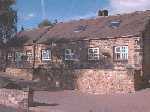SCHOOLS
There is evidence of education in the village as far back as 1656, when the
baptism of the son of the schoolmaster of Heddon, a Mr Dockery, took place.
Early schooling in the village would have been carried out by an assistant to
the parish priest, licensed to teach, by the bishop. The school would be held
in the seating area on either side of the church porch, available to those children
whose parents were willing and able to pay.
In the 17th and 18th century the children of those able to pay would
either have a private tutor/governess or would be sent to public schools. Schooling
was not compulsary and neither schools nor teachers were regulated
School 1 (1814) - Mrs
Margaret Bewicke built the first school in the parish, at Houghton in 1814,
primarily for the children of Close House estate to be educated at her expense.
It remained the only school in the area until the first "voluntary" school was
established in Heddon in 1852, by the Church of England.
School 2 (1852) - Land, opposite the Swan Inn, was
donated and conveyed to the vicar and churchwardens for the sum of £2.00.
The buildings were erected at a cost of £732-4-7, including the master's
house. The money was raised by subscription from landed gentry, such as Sir
Matthew White Ridley, George Burdon, Nathaniel and John Clayton and others,
and a grant of £200. The shortfall of £3 was donated by the vicar.
It being his fee for the marriage of Miss Stephenson of Throckley House
The day to day running of the school was the responsibility of
the vicar, aided by a management committee. Initially the school has two classrooms,
with a third added at a much later date. The first school master was a Mr.Scott,
who's annual salary was £55. The school mistress was a Miss Wilkinson whose
salary was £8.00 per year.
|
Attendance rose to over 100, and by 1888 was averaging 133 children.
When free elementary education was introduced in 1891 the average attendance
increased to 152. In 1902 the government took over the financial responsibility
of the running expenses of the school.
|
Class
photo 1908 (Click the image to see a larger version)
|
 |
|
Class
photo 1928 - with Schoolmaster Mr Fornier. (Click the image to see a larger
version)
|
Strong discipline was administered, the use of a "taws" or
leather strap being handed out, for what would seem slight misdemeanors
today. A former pupil, Mrs Betty Cockburn, recounted how in the 1920's,
being poor, she had few clothes and wore the same thin dresses summer
and winter. One day after arriving at school she was dragged out in front
of the class by the schoolmaster, to show everyone her dirty arms. They
were not dirty, mearly blue with cold.
On another occassion he was looking over her shoulder when some of his
snuff fell on her book. She quickly wiped it away, but her hit her on
her shoulder, twice, with a strap, for making a mess on her book.
|
 |
The marks were still on her shoulder when she got home, so her father
went to see the schoolmaster. She never knew what passed between them, but he
never touched her again.
During the period 1905 - 1932 private schooling was also given
at the vicarage for those children that wished to receive a higher education.
|
In 1952 the Church handed over financial responsibility for the school,
which therefore ceased to be "aided" and became "controlled".
In 1959 the older children were transferred to the new school at Walbottle
and only infants and juniors were educated in the village.
When the current school was built, in 1963, the old school was used as a
meeting place for the village Scout group before being sold and converted
into a private home. |
School 2 - now a private home
(Click the image to see a larger version)
|
 |
School 3 (1963) - The current school was started in 1962 and
completed in 1963. The building work being held up by the severe winter.
The school still thrives and now includes a nursery class. At nine years old
the children transfer to Coates Endowed School,
and are bused to Ponteland.


